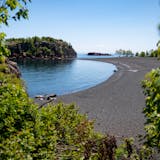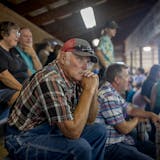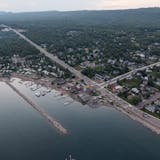TERROR, GENTLEMEN, ENEMY, BANK, EMPIRE, SLAVERY, WAGES, UNEMPLOYMENT, NUCLEAR, DEFICITS.
From every side, the words leap through space to assault the eyes. Bold words with strong import, they appear most often in the State of the Union addresses of 41 U.S. presidents.
In a fascinating show at the Weisman Art Museum, New York artist R. Luke DuBois has arranged the words in the form of Snellen charts, those black-on-white cards that optometrists use to test eyesight. The top line of DuBois' charts features the word uttered most frequently and the bottom line the word said least often. (He omitted articles and conjunctions.)
Called "Hindsight Is Always 20/20," the show was staged in part to coincide with the Republican National Convention. A variant of the exhibition was shown at the Denver Performing Arts Complex during the Democratic National Convention in August. There are no charts for the ninth president, William Henry Harrison, who died after a mere month in office, or James Garfield, the 20th, who served barely six months. Apparently neither of them gave a State of the Union address.
DuBois' clever analysis of the presidential verbiage is surprisingly revealing, oddly mesmerizing and curiously lyrical. Like refrigerator poetry, those happy conjunctions of words on little magnetic tabs, the presidential utterances read poignantly across the centuries. Since the speech-charts encircle the gallery, George Washington's GENTLEMEN and George W. Bush's TERROR flank the entrance, reflecting the very different tenor of their eras.
Certain words recall the preoccupations of their time, especially the 19th century's westward expansion (TEXAS, OREGON), muscular foreign policy (EMPIRE), injustices (SLAVERY) and financial uncertainties (WAGES). Some most-frequent words are predictable (Lincoln's EMANCIPATION, Eisenhower's NUCLEAR), but others are unexpectedly fresh. Who would pick TRULY, ENVIRONMENT, VISION as Nixon's most repeated utterances? Or DEFICITS, LET'S, BLESS as Reagan's. And some words, unfortunately, remain too relevant over the centuries (Lincoln's INSURGENT[S] and INSURRECTION).
Happily, the lists allow for creative interpretation. too. DuBois merely tallied and printed the words in order of frequency. Readers are free to give their own spin to such amusing coincidences as BEAUTY POLICE in the words of Lyndon Johnson, or ARMOR ALASKA in McKinley's addresses. Anyone wishing to delve deeper can read the complete speeches at information stations in the gallery. At a computer station, visitors may also predict the words that will be most used in the 2009 State of the Union address. On one recent afternoon, the top predicted word was HOPE. Imagine that.
Mary Abbe • 612-673-4431


